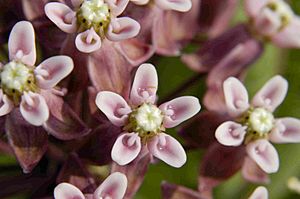Prairie milkweed facts for kids
Quick facts for kids Prairie milkweed |
|
|---|---|
 |
|
| Conservation status | |
| Scientific classification | |
| Genus: |
Asclepias
|
| Species: |
sullivantii
|
Asclepias sullivantii is a type of wild plant known as a milkweed. People also call it prairie milkweed or Sullivant's milkweed. It grows naturally in the central United States and in Ontario, Canada.
Contents
What is Prairie Milkweed?
This plant is a perennial herb. This means it lives for more than two years. It grows from deep underground stems called rhizomes. These rhizomes help the plant spread. The main stem of the plant can grow from about 40 centimeters (1.3 feet) to over one meter (3.3 feet) tall.
The leaves are shaped like an oval with a point. They grow in pairs on opposite sides of the stem. These leaves are smooth, thick, and feel like leather. Their edges are wavy, and they have reddish veins in the middle. The leaves also curve upwards on the stem.
Flowers and Reproduction
The flowers of the prairie milkweed are pale to deep pinkish-purple. They grow in round bunches. These bunches appear where the leaves meet the stem. Insects like bees and butterflies help pollinate the flowers. This means insects carry pollen from one flower to another.
After pollination, the plant grows a greenish fruit. This fruit is called a follicle. Inside the follicle are the seeds. The plant can also make new plants using its underground rhizomes. This is called vegetative reproduction.
How is it Different from Common Milkweed?
Prairie milkweed looks a lot like Common Milkweed (Asclepias syriaca). They can even mix their genes to create new types of plants. This is called hybridizing.
But you can tell them apart! Common milkweed leaves have blunt tips. Their undersides are also covered in tiny hairs. Common milkweed leaves grow straight out from the stem, not curving up. Its flowers are smaller and there are more of them. The fruit of common milkweed also feels rougher.
Where Does Prairie Milkweed Live?
Prairie milkweed naturally grows in prairies and meadows. It likes places that are a bit wet. You can often find it in river bottomlands.
The plant used to grow all over the tallgrass prairie. But most of this habitat is now gone. This is because people turned the land into farms. In the state of Minnesota, prairie milkweed is a threatened species. This means it is at risk of disappearing. The main reason is the loss of its natural home.
Some remaining plants are found along old railroad tracks. These areas are like small pieces of the original prairie. Prairie milkweed needs healthy, moist tallgrass prairies to survive. It does not do well in places where its habitat has been damaged.
Who Visits Prairie Milkweed?
Many insects visit prairie milkweed to drink its sweet nectar. These visitors include bumblebees, other bees, wasps, ants, flies, and many types of butterflies.
Insects and Other Animals
The caterpillars of the famous monarch butterfly love to eat the leaves of milkweed plants. This is why milkweeds are so important for monarch butterflies.
Other insects also interact with the plant:
- The larva (young stage) of the milkweed leaf-miner (Liriomyza asclepiades) digs tunnels inside the leaves.
- Different types of aphids can be found on the plant. These include the yellow milkweed aphid (Aphis nerii), the black aphid (Aphis rumicis), and the green peach aphid (Myzus persicae).
- The ruby-throated hummingbird also drinks nectar from the flowers.
Is Prairie Milkweed Safe?
Most milkweed plants, including prairie milkweed, can be harmful if eaten in large amounts. They contain natural chemicals called cardiac glycosides. These chemicals can affect the heart. So, it's best not to eat any part of the plant.


